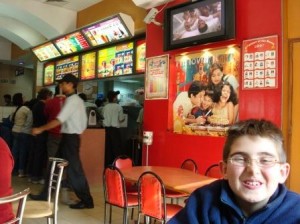Since having moved to the US when I was seven, I’ve gone through various phases of adjusting and adapting to a new culture and figuring out what parts of two cultures I wanted to integrate. Some of this has been conscious, some not. There were swings of loyalty. On a study abroad trip to Rishikesh, India in 1990 when I was 22, students could visually see these swings in the attire I wore. One day I would wear a sari and the next jeans. I started the days at the ashram early with a candlelight, reading the Bhagavadgita, which we were studying, and listening to bhajans, with the sound of the Ganges nearby. I had never felt more at peace.
Over the years, I’ve come to realize that there are many factors that play into how people respond to a different culture and to the extent that they adapt. South Asians from India have come to label people as “FOB” (fresh off the boat) or “ABCD” (American Born Confused Desi). I’m realizing that there are many grey areas between these labels where most people from India fit. There are people in India that could be labeled “ABCD,” even though they may never have lived or visited the US.
By the same token, I know Indians that were born in the US that could be labeled “FOB,” and may have just taken a few trips back to the “motherland.” This has much to do with the culture they find themselves in at the time and how this resonates for them at a personal, individual level. As the world becomes more global, there are increasing numbers of Indians in India that live in a very Western world within India, although it may be a stereotype of a Western world. Some of these changes can be seen in portrayals in Indian cinema, at least in terms of what appears to be “cool,” even if many may not live those lifestyles.
For instance, in “Pyaar Ke Side Effects,” dating appears to be common, along with premarital sex (being accepted) and women living on their own. The attire is almost entirely Western, and there is even open kissing! The theme is a typical Western theme, of a non-committal guy and a woman ready to get married after dating a long time, and who is also a “runaway bride.”
It seems counterproductive to try to label others or ourselves on some range of FOB to ABCD. With increasing globalization, it will become irrelevant. We are just people that resonate with different aspects of different cultures we are exposed to at different levels based on our different temperaments and personalities, some of which we are born with and some we develop from our experiences. 






 It was strange to see houses shaped like boxes from the plane. There was so much symmetry and apparent order. I saw alienating fences for the first time. At my father’s duplex that evening upon arrival, the first thing I did was tap on the walls. I had heard that all the houses in America were made out of wood. I didn’t believe it, so now I was confirming in disbelief. In India, our house along with neighbors’ was made out of stone, cement, and bricks. These homes in American seemed as if they could be blown over by a strong gust of wind.
It was strange to see houses shaped like boxes from the plane. There was so much symmetry and apparent order. I saw alienating fences for the first time. At my father’s duplex that evening upon arrival, the first thing I did was tap on the walls. I had heard that all the houses in America were made out of wood. I didn’t believe it, so now I was confirming in disbelief. In India, our house along with neighbors’ was made out of stone, cement, and bricks. These homes in American seemed as if they could be blown over by a strong gust of wind.